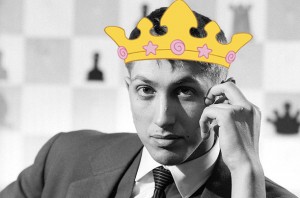
Some things my daughter has in common with Bobby Fischer:
–She’s part German and part Jewish, just like Fischer, whose status as mixed-race diaspora-child made his late-life anti-Semitism all the more confusing.
–She is also part Mexican and part Japanese, which Fischer was not. But he was conceived in Mexico, or so Wikipedia tells me, and the Japanese detained him for nine months at one point, during his crazy embargo-breaking, hunted, stateless stage.
–She loves Iceland, and so did he. It’s true: more than a month after we visited that strange and gnomic (and proggy) country, Dalia still like to pretend that the floor is actually lava, which is either a fun little game for preschoolers or totally fucking terrifying. As for Fischer, Iceland was just strange and gnomic enough to actually give him citizenship when nobody in the world wanted him but the Japanese, and they only wanted him so they could jail him indefinitely. He liked it so much he died there.
–She loves chess. Really loves it. Since, like, a week ago. All she wants to do is play chess, which is somewhat surprising to me because she’s just five and she hasn’t really had an intellectual moment in her whole life so far. Some moments of insight, yes, and perhaps some wise-beyond-her-years utterances. But nothing so far where she has taken her child-mind and concentrated it on the odd puzzles and games of the adult world. Until now.
–She is quite good at sacrificing her queen. Unlike Fischer, though, who sacrificed his queen in the “Game of the Century” in ’56 and then proceeded to immediately beat the shit out of his opponent even without his queen, Dalia just sacrifices her queen, pouts, and then generally collapses in a heap while I threaten to put away the board and make her go brush her teeth.
–She, like Fischer, has a severe and demanding father. I trounce her pitilessly on the chess board, not because I can actually play chess beyond knowing how the pieces move, but because she is only five and has limited spatial reasoning and somewhat magical thinking. I also beat her because I feel it is dishonest to let her win now, because beating me is actually a quite attainable goal, as long as she realizes she hasn’t achieved it yet. Although even now I do, if I have time on my hands, advise her in ways that draw out the game, so her inevitable queen-sacrifice takes longer to arrive.
This is, at any rate, a fine development for a young girl whose other passion is, as it undoubtedly was for Bobby Fischer late in life, the Island of Sodor.



